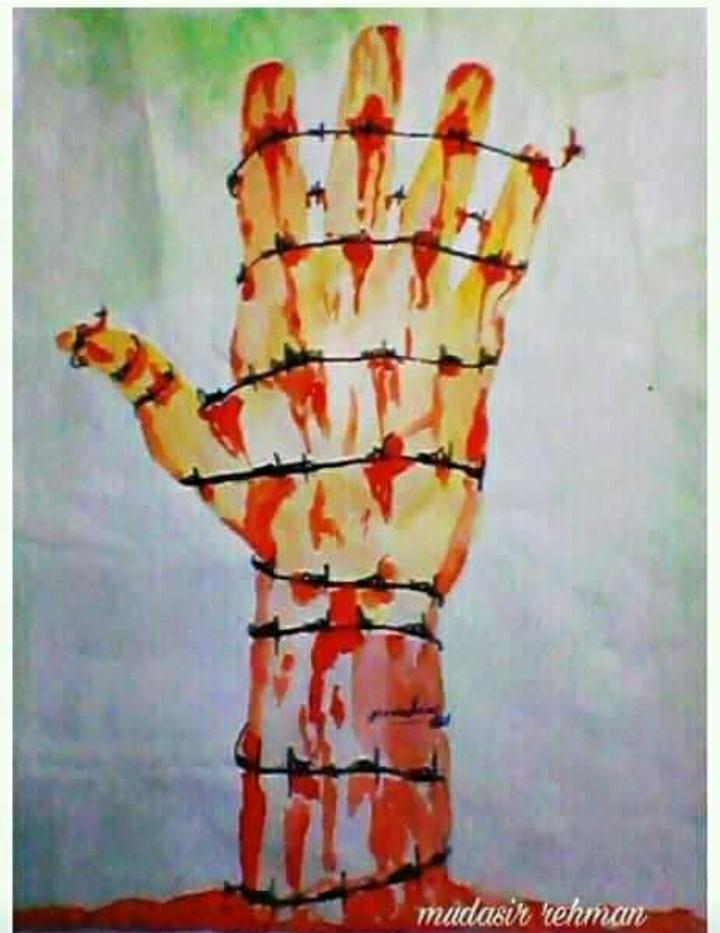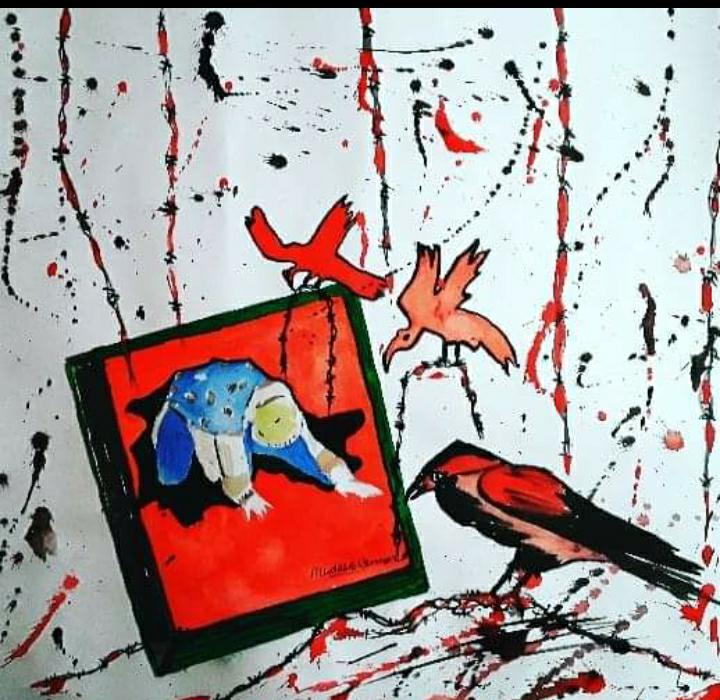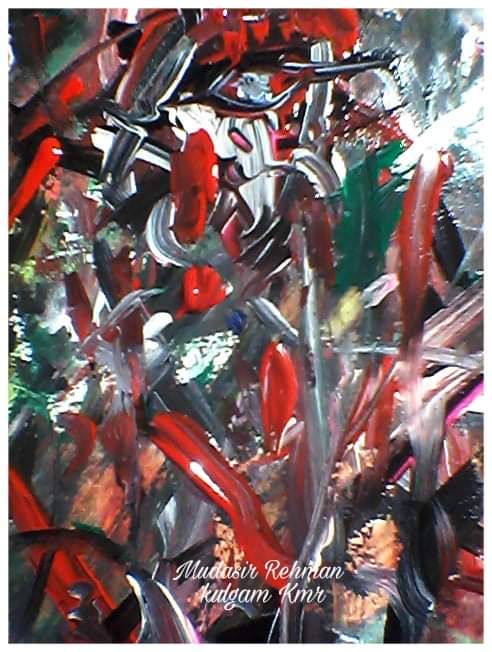After Article 370 was struck down by parliament on August 5, 2019, Shahid Mudasir (the pen name of Mudasir Rehman Dar), 28, an artist by passion and painter by profession, believes he has not been able to freely express what he wants to on canvas. Fearing reprisals from the authorities, he has been very careful about what subject matter to choose.
A resident of south Kashmir’s Kulpora village in Kulgam district, Dar is a daily wage labourer and a school dropout. He draws from his imagination and has never been to any art institution to learn the craft.
Most of his paintings have blood, barbed wire, death, pain and suffering as themes.
“I used to make paintings with different messages. I usually tried to focus on social evils through my artwork, like drug addiction, child labour, and other social injustices besides the ongoing conflict,” Dar said.

The Burhan Wani sketch
According to him, a real artist is one who portrays what he observes in his surroundings and here, in Kashmir, blood is splattered everywhere, irrespective of sides.
“Initially I used to make portraits of friends. I also met state awardee artists for guidance. And my painting also got displayed through the cultural academy of J&K government,” he said. “Most of my paintings are posted on social media and it is the only platform which allows me to share my work with my admirers. However, there are no monetary benefits.”
In 2007, his militant cousin, who he treated like a friend, was killed and this had an impact on the artist. To vent, he started drawing and according to him, he portrayed why youth are forced to pick up arms and why people die and how they live everyday life. He sketched what he saw.
But now he cannot.
Most of his artwork depicts the pain and suffering that Kashmir has been witnessing for many decades.

In 2016, after the killing of Burhan Wani, security agencies questioned Dar about his work. He had to take down a sketched image of Wani from social media after it went viral. When the authorities asked him as to why he had painted Wani, he had told them that he was an artist. “I can draw any human being in the world,” he said.
Wani’s killing had triggered widespread protests in Kashmir. “I did not draw him considering him a hero, but a Kashmiri and a human being. I told them I was an artist who can draw sketches of Mahatma Gandhi and Bhagat Singh also,” he said.
Following August 5, 2019 as laws were used to stifle dissent and many people were detained, he resorted to drawing different themes of social issues like drug addiction, rapes, child abuse and child labour.

“The media is not free. How can an individual, an independent artist be?” he said, talking about how he fears reprisals from authorities if any content offends them.
Despite short stints of fame and association with art groups, he has been craving a platform to display his talent despite winning several awards at mega stages. Even many organisations, according to him, disowned him because of what he used to portray.
Dar says that Kashmiri youth are talented but they lack platforms where they can show their talent. “I cannot afford paid exhibitions or even submit a registration form,” he said as most of his work remains confined to his room and likes of social media.
According to him, he is mostly into abstract and modern art now. “I want peace in the world through my paintings, and freedom to express the imagination.”
Mudasir Gull’s detention
Similarly, another artist, Mudasir Gull, a resident of Srinagar, who was detained a few months ago after his painted mural drew in support of Palestine had gone viral on social media, is focused on drawing group murals in public places and avoids any contentious themes.

The pro-Palestine mural which got Gull arrested. Image: special arrangement.
When Israel’s bombardment on Palestine invited worldwide condemnation, he too expressed solidarity with victims through a mural. But that did not go well with the authorities and he was detained and counselled.
Gull has a degree from Srinagar’s College of Fine Art.
“Because of some restrictions, we cannot do graffiti art. I had a misunderstanding at that time. I thought it is not aggressive, anti-social or controversial,” he said. “Before my detention I did not know it is illegal. I had never expressed myself that way before as I used to work on realistic art,” he said. The authorities later scrubbed the painting from the bridge.
“I used to draw landscapes and portraits. Now, I am doing new artwork which reflects the experience of what I faced and my observations. It will be emotional and thought-based,” he said, as he wants to bring feelings to the canvas through abstract art.
“I have a new work to showcase and it is personal. It will be different from the past,” he said.
Closing eyes to larger political realities, he does not want to touch contentious themes.
“I had no intention to disrupt public order through my art as I expressed sympathy and solidarity with fellow Muslims suffering in Palestine. As an artist I expressed my feelings through my painting,” he said as it was his first attempt.
Khalid Bashir Gura is a Kashmir-based journalist working with Kashmir Life and is a media scholar at the University of Kashmir. He tweets @khalid_gura.
All images provided by the author

